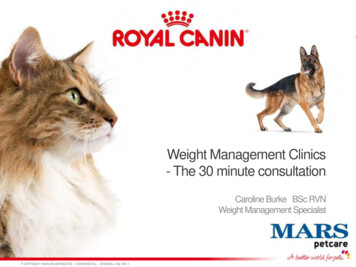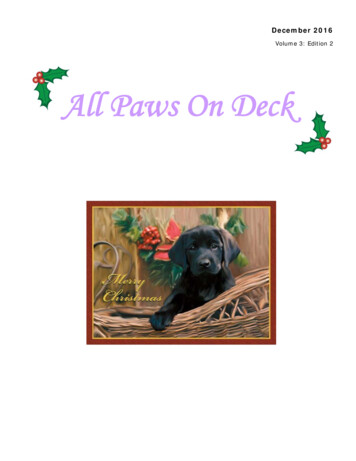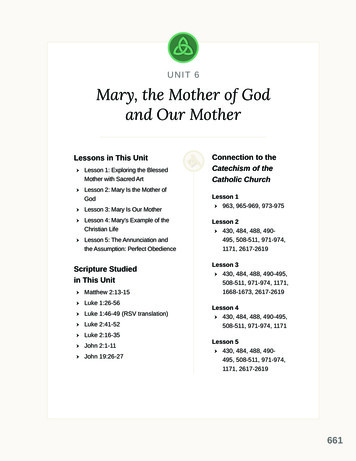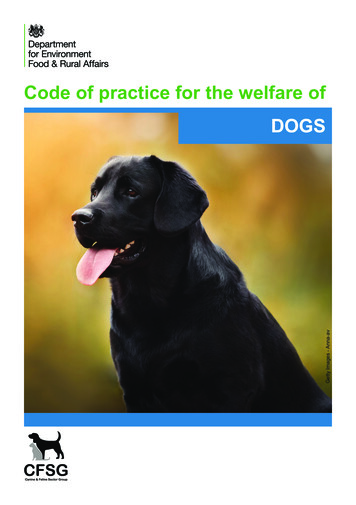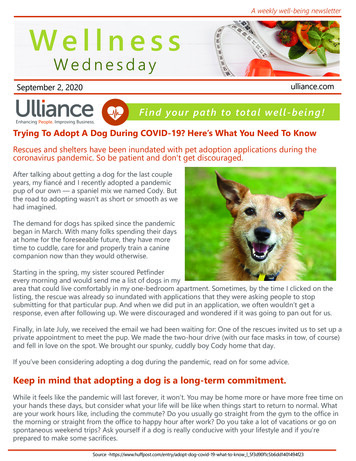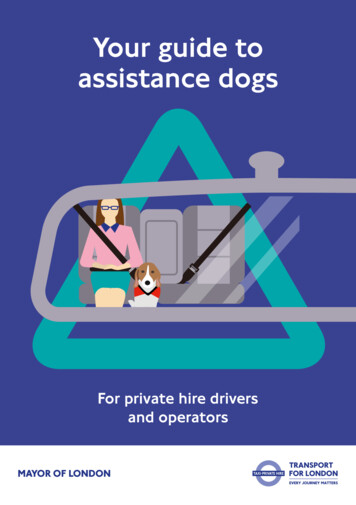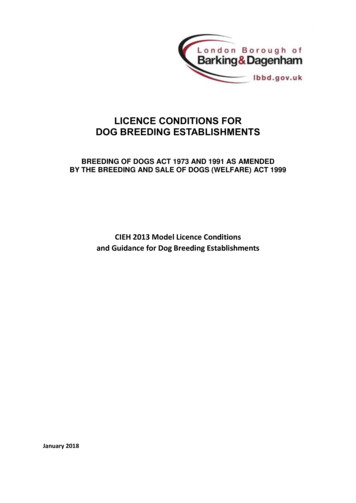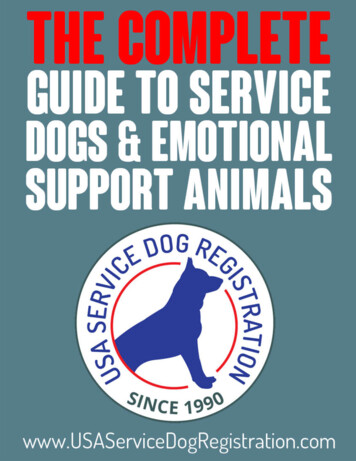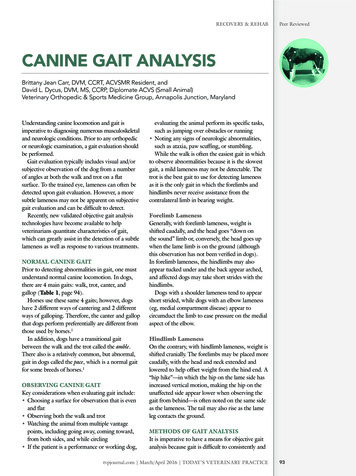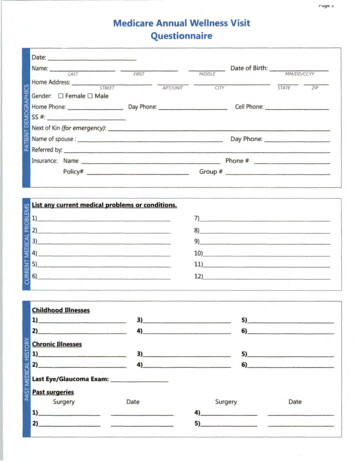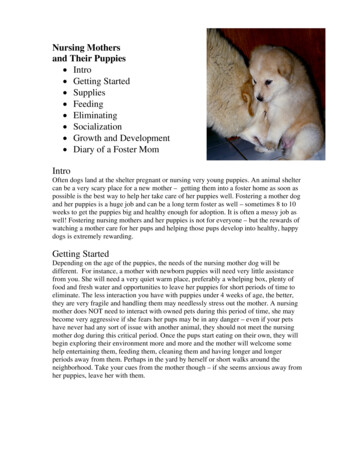
Transcription
Nursing Mothersand Their Puppies Intro Getting Started Supplies Feeding Eliminating Socialization Growth and Development Diary of a Foster MomIntroOften dogs land at the shelter pregnant or nursing very young puppies. An animal sheltercan be a very scary place for a new mother – getting them into a foster home as soon aspossible is the best way to help her take care of her puppies well. Fostering a mother dogand her puppies is a huge job and can be a long term foster as well – sometimes 8 to 10weeks to get the puppies big and healthy enough for adoption. It is often a messy job aswell! Fostering nursing mothers and her puppies is not for everyone – but the rewards ofwatching a mother care for her pups and helping those pups develop into healthy, happydogs is extremely rewarding.Getting StartedDepending on the age of the puppies, the needs of the nursing mother dog will bedifferent. For instance, a mother with newborn puppies will need very little assistancefrom you. She will need a very quiet warm place, preferably a whelping box, plenty offood and fresh water and opportunities to leave her puppies for short periods of time toeliminate. The less interaction you have with puppies under 4 weeks of age, the better,they are very fragile and handling them may needlessly stress out the mother. A nursingmother does NOT need to interact with owned pets during this period of time, she maybecome very aggressive if she fears her pups may be in any danger – even if your petshave never had any sort of issue with another animal, they should not meet the nursingmother dog during this critical period. Once the pups start eating on their own, they willbegin exploring their environment more and more and the mother will welcome somehelp entertaining them, feeding them, cleaning them and having longer and longerperiods away from them. Perhaps in the yard by herself or short walks around theneighborhood. Take your cues from the mother though – if she seems anxious away fromher puppies, leave her with them.
Supplies Whelping box if pups are under 4 weeks of age.An upside down ½ of a crate will work, alarge box with a small walkway cut out, ababy pool or baby gating an area off so thepuppies stay close to the mother. Themother needs to be able to easily leave thearea to eliminate away from her puppies andstretch her legs as necessary. Changebedding regularly and make sure the area isfree of drafts. Keeping a very eventemperature is very important. Newspapers Keep several layers in thebottom of the box, and they will come inhandy when the puppies start to roamaround the room.Water bowls Heavy and impossible to tip.Should be stainless steel orporcelain/ceramic, NOT plastic, as plasticis difficult to disinfect because it is soporous.Food bowls (one more than the numberof dogs you are fostering) One is for theeat-at-will dry food, the other for cannedfood. You can use TV dinner trays, paperplates or whatever you have; any relativelyflat plate or saucer will do. The larger thelitter, the larger the plate should be so thatno one gets crowded out.Food The shelter will provide both hardand canned food for your foster puppies.Plenty of clean towels and blanketsToys Plastic, disinfect-able toys are goodto reuse for new litters. Clean tennis ballsand old stuffed socks.Baby gates and exercise pens Forconfining the puppies as needed
FeedingAge 0-4 WeeksMom: The nursing mother dogshould be offered plenty of food atall times – nursing puppies isincredibly hard work and hercalorie intake needs to be muchhigher than a non-lactating dog.Most dog food printsrecommended dosing for lactatingmother dogs on the label. Makesure she always has access to hardkibble and fresh water becauselactating dogs also tend to drinkmore than non-nursing dogs. Throughout the foster period, feed mom as much as she willeat – you cannot over feed a momma dog!Puppies: Puppies should nurse vigorously and compete for nipples. Newborns can nurseup to 45 minutes at a time. Be sure to watch puppies nursing at least once a day, if themother will permit it. Check that everyone is nursing and that there isn't too muchjockeying for position. A great deal of activity and crying could indicate a problem withmilk flow, quality or availability. When the mother reenters the box, there should besome fussing for only a few minutes before everyone has settled down to serious nursing.Puppies will sleep 90% of the time and eat the other 10%.Age 4-5 WeeksPuppies usually can drink and eat from a saucer by 4 weeks. Weaning should be donegradually. Introduce them to solid food by offering warmed canned food, mixed with alittle water into gruel, in a shallow saucer. You can begin by placing one puppy by theplate of canned food gruel, and hoping for the best - if she starts eating, great! Herlittermates will probably copy her and do the same. Some puppies may prefer to lick thegruel from your fingers, if this is the case; slowly lower your finger to the plate and holdit to the food. This way the puppies will learn to eat with their heads bent down. Thepuppies will walk in it, slide in it, and track it all. Be patient, sometimes it takes two orthree meals before they catch on.Age 5-6 WeeksFeed gruel 4 times a day. Thicken the gruel gradually by reducing the amount of watermixed with it. Introduce dry food and water. If you are fostering a litter with their mother,continue weaning. For reluctant eaters, try mixing some puppy milk replacer into thegruel or tempt the puppy with some meat-flavored human baby food mixed with a bit ofwater. The familiar formula taste and smell or the meat flavor of baby food is often moreappealing to the picky eaters than dog food. Once the puppy accepts the formula basedgruel or baby food gradually mix in dry puppy food until the puppy has been weaned likethe other puppies.
Age 6-7 WeeksBy this age the puppies should be eating dry food well. Feed the puppies at least threemeals daily. If one puppy appears food-possessive, use a second dish and leave plenty offood out so that everyone can eat at the same time. Although the puppies may not eatmuch at a single sitting, they usually like to eat at frequent intervals throughout the day.Age 7-8 WeeksFeeding: Offer dry food 3 - 4 times a day. Leave down a bowl of water for them to eatand drink at will. If you have a litter with a bitch, she should only be allowing briefnursing sessions, if any. Do not feed the puppies table scraps.Age 8 weeks and overFeeding: Offer dry food 3 times a day. Leave down a bowl of water for them to drink atwill.EliminatingDuring the first 2-3 weeks of life puppies do not urinate and defecate on their own. Thisis stimulated when the mother is cleaning them. As the mother stops taking care of theireliminating needs but before the pups get the idea of eliminating outside of their nest,there will be A LOT of cleaning up for the foster provider to take care of. However, youcan begin housebreaking at four weeks of age. This can be done by using a pile ofnewspapers or training pads in a corner. After each feeding, place the puppy on thepapers, or outside, for him to go to the bathroom. Be patient! He may not remember to dothis every time, or may forget where to find the papers, but he will learn quickly. Be sureto give the puppies lots of praise when they first start using their papers or cry to go out.It is a good idea to confine the puppies to a relatively small space, because the larger thearea the puppies have to play in, the more likely they will forget where the papers are.Keep the papers clean and away from their food.
SocializationMomma dogs will undoubtedly appreciate NOT having to deal with any other animalswhile they are nursing their puppies. Protecting and nurturing her puppies is her numberone priority and any other animal could be seen as a threat to their safety, no matter howfriendly they are. Keep momma dogs isolated from other pets in the home until you arecertain she is very comfortable and completely non threatened, keep in mind this may bethe entire time she is in your home. Once the puppies are around 5-6 weeks and cantolerate time away from mom, you can begin to introduce them to other animals in yourhome.Growth and DevelopmentIn the 2 first weeks of life puppies are helpless and vulnerable. They are still developingbasic reflexes, their hearing and vision is still not fully developed, and they are unable toproperly control their body temperatures. They should therefore be confined to thenursery area. Young puppies should be kept in a large box or kennel lined with a towelfor easy cleaning. It is very important to keep the puppies warm, especially during thefirst 2-3 weeks of life. A heating pad or a warm water bottle can be ideal sources ofheating. If you use a heating pad make sure it only covers half or parts of the nursing areaso that the neonates can move away from the heat if they need to, and also make sure it isset on "low" and that the electrical cord is out of reach of sharp little puppy teeth. Themore puppies in your litter, the better able they will be to keep warm by sleeping togetherin a heap. Small litters and singletons need more help keeping warm, singletons will alsooften find comfort in a stuffed fluffy toy to snuggle up to. Keep neonates away fromheaters or cold drafts. As the puppies get older, from 4-5 weeks of age, they can beallowed to roam a larger area of your house, but they should still be closely supervisedand kept in a secured area when not confined to their nursing area. Remember thesepuppies are still very vulnerable to infections, such as canine parvo infection, and shouldbe separated from other pets if possible, and only be allowed to interact with fullyvaccinated, healthy dogsAge 0-2 weeks: Ear canals open between 5 and 8 days. Eyes will open between 8 and 14 days. They open gradually, usually starting toopen from the nose outward. All puppies are born with blue eyes, and initially nopupils can be distinguished from the irises - the eyes will appear solid dark blue. Healthy puppies will be round and warm, with pink skin. If you pinch themgently, their skin should spring back. When you pick a puppy up, it should wiggle energetically and when you put itdown near the mom it should crawl back to her. Healthy puppies seldom cry.
Age 2-3 weeks: If there is a mother, she will begin to spend larger periods of time out of the nest,though she will not go far from it. Puppies begin to crawl around day 18 and can stand by day 21. They will begin to play with each other, biting ears, tails and paws even beforetheir teeth have come in. Their milk teeth are cut during this period. They learn to sit and touch objects with their paws. Puppies begin their socialization phase - they will be strongly influenced by thebehavior of their mother for the next six weeks. To further socialize puppies,increase the amount of handling, and get them accustomed to human contact. It isimportant not to expose them to anything frightening; children may seemintimidating and should be supervised closely while visiting to ensure gentlehandling.Age 3-5 weeks Adult eye color will begin to appear, but may not reach final shade for another 9to 12 weeks. Puppies begin to see well and their eyes begin to look and function like adultdogs' eyes. Puppies will start cleaning themselves, though their mother willcontinue to do most of the serious cleaning. If there is a mother present, she will usually begin weaning by discouraging herpuppies from nursing; however, some dogs (particularly those with small litters)will allow nursing until the puppies are old enough for permanent homes. Somenursing activity is the canine equivalent of thumb-sucking, that is, for comfortonly. Even if puppies appear to be nursing, they may not be getting all thenutrition they need from mom. Make sure they are eating food and gainingweight. Be sure that the puppies always have access to fresh water in a low, stable bowl.Age 5-6 weeks At about five weeks, puppies can start to roam around the room, undersupervision. The strongest, most curious puppy will figure out how to get out ofthe nest. The others will quickly follow. Be sure to take them to their papers or outside after meals, during play sessions,and after naps. These are the usual times that puppies need to eliminate. Vaccinating and de-worming: Starting at about 4 weeks, puppies should getbooster shots and de-worming every 2-3 weeks for a series of 3.
Age 6-8 weeks By this time, you have "mini-dogs." They will wash themselves, play games witheach other, their toys, and you, and many will come when you call them. This is a very entertaining time to have puppies – they play hard, sleep hard andare learning all about their world. Socialization is KEY during this period to makesure the puppies learn not to be threatened by new things.Age 8 weeks Puppies should now be ready for adoption if they are free of any symptoms ofillness (runny nose, cough, diarrhea or hair loss). Take pictures of your puppies individually, cropped horizonally, and titled bytheir animal ID number and e-mail them to the foster coordinator for posting onthe AAC website. Arrange for the puppies and mom to spayed or neutered and microchipped so theyare ready for adoption!The following is a lovely detailed diary from one of ourvery first foster mom’s to have newborn puppies in fostercare, her ideas, observations and suggestions are veryhelpful!
Diary of a Foster MomI fostered an awesome Chihuahua mix mom and her 7 puppies from the end of Septemberuntil mid November. I had them from when they were about 5 days old until they were 8weeks. And happy to say, they've all been adopted and are with their forever families. Itwas an amazing experience that I will definitely be doing again.From about 5 days to 3 weeks, they were mainly taken care of by their mom. I had anextra room that really came in handy because I also have an older male dog that was verycurious about the puppies, as well as two old lady cats who weren't thrilled with havingthese weird new creatures in the house. If you don't have an extra room, I wouldrecommend putting them in a large closet or a bathroom. Having a closed off space, Ithink, made her feel more comfortable. Sweet Pea (the mom) was really, really, reallyprotective of these puppies. She warmed up to me right away but as soon as she saw mydog and was with the puppies, she would start barking at him. My advice withintroducing them would be to let her get used to her space first and keep your dog as faraway from them as possible. Once she's cool with you being around the puppies, then Iwould take her out and play with her and pet her as if she's your pet. This is when youcan introduce her to your dog. I never let my dog in the puppy room and eventually hewasn’t even that curious anymore. You will be amazed at how fast your momma dog cango from being smart, instinctual protective mom dog to being happy to please pet dogwhen taken away from her litter.
In the times when I took her away from her litter to go to the bathroom, hang out withme, and have some "time off" from being a food source :), I would leave the door open tothe room and put up a baby gate so that she could hear and see her puppies at all times.When I took her out, she would do her business pretty quickly and then want to get rightback to them. If she was hanging out with me and heard just a little peep out of one ofthem, she'd go running back in there to check it out. I forget why I did this, but one time Iput her out of the room and shut the door while tending to the puppies and that was a bigmistake because she became frantic - so I'd recommend never doing that - make sure shefeels like she can always get back to them if she needs to.While she was still nursing a whole bunch, and cleaning up after the pups (something thatwas a surprise to me! It's kind of gross that she will eat all their waste but it actuallymakes your job a lot easier and teaches them not to go potty where they sleep and eat)during this time, I had her on wet dog food and she ate like a horse!! That meant that shehad to go to the bathroom A LOT and it's usually pretty runny (I really don't mean to begross but I had to find out that this was pretty normal and that she wasn't sick.)
My set up in the room was as such: I bought a couple of big plastic sheets and twocanvasses - the kind that you get at home depot as drop clothes for painting. The plasticsheets were about 2 a piece and the canvases I think were about 8 a piece. I laid onepiece of plastic out and covered it with one canvas. (I suggest multiple because you willthrow out the plastic once it is dirty and launder one canvas while the other is beingused.) I put out a couple of puppy pads for house training. These come in handy when thepups are only a couple of weeks old because the mother will be going to the bathroom ALOT and she will need to use those when you aren't able to take her out 8x a day andwhen the pups are older, they will tend to use those (and a lot of other places too). I alsobought a baby pool (the only place I could find these was actually at PetSmart since itwas fall and walmart and target weren't carrying them that time of year). This kept thepuppies contained for the first couple of weeks. Your little ones look like they mightalready be at the stage when they would be getting out of the baby pool so not sure if thisis necessary. The baby pool was the cheap version of a whelping pen. In the baby pool, Iput more puppy pads and on top of those I put baby receiving blankets. (This was a greattip I learned online). They are super cheap - like 5 for 10, easy to clean, and plus theycome in adorable prints. :) I read that you should get a heating pad for them but theytended not to sleep on it and since I don't keep my house too cold, it wasn't really needed.Oh and LOTS of paper towels!!I was also kind of a nervous nelly when it came to their health and since I'm not a vet theonly way I could tell that they were healthy was to weigh them. (This might have beenoverkill though). I got a little food scale with a basket and weighed them every day for awhile and then every couple of days to make sure that they were gaining weight. Theygained almost an ounce a day pretty consistently.One thing I kept seeing on puppy raising websites as a tip, was to clip their toenails.Since they are sooo tiny, a regular dog clipper won't work but since I have cats I had a cattoe nail clipper that worked great. They recommend this because when they are nursingthey are digging their paws into the mom and this can hurt her. I did this once a week andsince they were so little they didn't seem to mind. (I wish I had actually started this whenmy dog was a puppy because he HATES getting his nails clipped now!)
As far as feeding, once she started to seem somewhat annoyed at nursing - about 3 to 4weeks, we started them on puppy food - a blender is definitely necessary for this. Thefirst time I tried it I blended it up with some luke warm water and they seemed somewhatuninterested. Then my boyfriend microwaved some water and blended it up so it wasreally warm and they took to it immediately!! This is the time that started feeding SweetPea dried food. She liked to eat the puppy mush though too so just try to be aware if themom is eating all the food that was meant for the pups. And as far as water, I wasconcerned because for a while they were just nursing and eating the mush and didn't gonear the water dish. Then just naturally with no reason, they started drinking from thewater dish. They were still nursing up until I dropped them off at TLAC but usuallySweet Pea snapped at them if they tried once they were about 6 weeks.That brings up something that really concerned me and my neighbor said was verynormal. After a while, Sweet Pea would growl and grab them by their legs or their headwith her mouth and I really thought she was hurting them! But apparently that is themomma dog's way of teaching her pups right from wrong.At about 4-5 weeks I had removed the baby pool from the room and they just slept on adog bed all together and put out a few blankets. I also had a futon in the room that SweetPea could jump on and the puppies couldn't. She seemed to really like this since at night Istill kept her closed in the room with the puppies. She could still keep an eye on them butshe was up away from them so that they weren't constantly bugging her for milk. I wouldsuggest having some place that she can sleep that they cannot get to but she can still bewith them.
This is also around the time that they understood that the door to the room wasn't the"end" of their world and they wanted to get out and explore. This is when they get funand very very messy. I let them out to play with me in the living room and there weremany accidents. I did not discipline them since they are way too young to understand just cleaned up their mess. (At this point, the mother dog is done doing that for you!!)At about 5-6 weeks, I started taking them outside. At first they were kind of terrified some more that others. And as soon as one would start whining, they all would start even ones that looked like they were enjoying themselves. After the third time out, it washard to get them all back inside they LOVED the backyard. Watch out for holes in yourfence, or holes underneath sheds or decks because they will definitely want to checkthose places out. Once you can take them outside you can start on mild house training. Itook them out about 5 times a day - once immediately in the morning when I heard themwhining at the door, three times during the day, and once before bedtime (around 9PM this time is kind of arbitrary - I just did this so my cat could come in the house since shewouldn't if the puppies were out of their room.) Surprisingly, they really would rather goto the bathroom outside and would go as soon as I took them out. Though still notdisciplining for accidents in the house - that's something I would leave up to their ownersonce they are adopted.At this point, my dog Ferris had become buds with Sweet Pea when the puppies weren'taround. She was spending less and less time with them - wanting to take a nap with me orusing the dog door to hang out outside by herself or with Ferris. If she is outside byherself, make sure your fence is really sound. I never witnessed this but my neighbor toldme that a few times stray male dogs came sniffing around the fence and Ferris barked atthem until they went away. Since she isn't spayed, apparently she will still attractunwanted male attention. As far as Ferris, I'm not sure if I created a situation where hewas jealous of the puppies or if this is the way cranky old men dogs act around puppies,but they were REALLY interested in him and he didn't like it. They would follow himaround and he would turn towards them and they would immediately sink to the grassand belly crawl towards him. He'd make this weird growl and snap at them but never ever
bit them. I would just keep an eye out if you have an older male dog just to make sure hedoesn't take it too far. The puppies, I guess, thought he was playing because they neverlearned to leave him alone.At about 7 weeks, they learned to use the dog door and my life for about a week wasspent counting to 7 to make sure all of the puppies were constantly accounted for. I hadgotten different colored collars for each of them so that made it easier to know from adistance which puppies were which. Obviously, if I ever left the house, the puppies wereput in their room. At this point, they were also eating regular puppy food without beingblended. (I bought the big bag of Fromm's Puppy Gold in the pink bag from Bark n Purrwhich they liked). This is also the point where I started posting on Craigslist which Iactually have some advice about as well. I tried to post one post for each puppy andcraigslist thought I was spamming so would only let me post three of the puppies listings.(This was the first time I ever posted something to craigslist so that might be commonknowledge). Also, I posted that I would send and take applications, this kind of turnedinto a mess. I would recommend that you direct people to the shelter to fill out theirapplications where they can take the ID number posted in your craigslist ad and put it onthe application and let the shelter deal with approving applications.
At 8 weeks, I got them all together and dropped them off. They were getting spayed andneutered and microchipped at the shelter and their new adoptive parents were pickingthem up after their surgeries. It was a really tough goodbye after loving and caring forthem for so long but I’m trying to stay in touch with the adopters so I can get updates onhow the whole family is doing!
Nursing Mothers and Their Puppies Intro Getting Started Supplies Feeding Eliminating Socialization Growth and Development Diary of a Foster Mom Intro Often dogs land at the shelter pregnant or nursing very young puppies. An animal shelter can be a very scary place for a new mother - getting them into a foster home as soon as .
